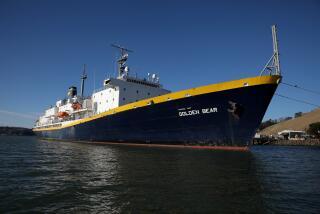Learning Their Lessons at Sea
- Share via
As the wind propelled the Robert C. Seamans toward Santa Catalina Island, Rudy Vigil controlled the helm of the 135-foot, $8.1-million ship.
Rudy is 17, with a ring in his eyebrow and a stud in his nose. The last thing the high school senior from Wilmington steered was a Honda Civic.
Rudy was seasick for most of the 10 days he and 20 other students cruised the California coast with the Sea Education Assn., keeping watch around the clock, analyzing water samples and scrubbing the tall ship’s teak decks. But he always tried to keep his sense of humor.
“If you wanted to look for me, you’d see me over the rail,” Rudy said.
The nonprofit sailing-and-science association has dropped anchor on the West Coast. For 30 years, more than 5,500 high school and college students have steered SEA’s tall ships through the Atlantic and Caribbean, combining their cruises with classroom time at the SEA campus in Woods Hole, Mass.
With the Robert Seamans cruise from Monterey to Catalina, which ended Friday, SEA launches a program that will give students academic credit to sail to Costa Rica, Tahiti, Hawaii, the Midway Islands and the Pacific Northwest.
The Beverly Hills-based Ahmanson Foundation and Buckley School in Sherman Oaks paid the $3,300 tuition per person for Rudy and six other Southern California students to spend 10 days studying 20 varieties of seaweed and snorkeling with leopard sharks at USC’s Wrigley Institute Marine Science Center on Catalina. The other teenagers, who paid their own way, came from other parts of California and the nation.
“California was supposed to be warm--that’s what I was told,” said Christine Horgan, 16, of Boston. Persistent fog and gale-force winds taught her otherwise.
The Robert Seamans, commissioned in June and named for a former NASA administrator and secretary of the Air Force, has the look of a 19th century schooner but the technology of a marine biologist’s laboratory.
Students use computers to map the sea floor, take readings of chemicals in the water and write reports they present to classmates and the marine scientists who teach them.
While the science is 21st century, the sailing is not. The new ship is loaded with digital gadgets to pinpoint its position, but Capt. Virginia Land is big on making students chart the ship’s course using celestial navigation. Students pull the boat’s lines and furl her sails by hand.
“It’s not a cruise,” said Kris Perez, 18, who just graduated from San Pedro High School. “It’s the exact opposite.”
Tall ships have become popular tools for teaching responsibility to young people, Land said, because “they’re presented a task that is bigger than any one person.
“On the boat,” she said, “if you don’t show up for watch, somebody else is suffering.”
Rudy earned his spot on the Robert Seamans because he sailed four years ago with Jim Gladson of the Los Angeles Maritime Center, who takes at-risk teenagers on tall-ship cruises locally.
Gladson’s boat happened to pass the anchored Robert Seamans on Friday, and Rudy rushed to the rail--this time to call to the skipper.
“Hey, Jim! Jim! It’s Rudy!” he yelled across the cove. “Thank you for this wonderful trip.”
More to Read
Sign up for Essential California
The most important California stories and recommendations in your inbox every morning.
You may occasionally receive promotional content from the Los Angeles Times.













